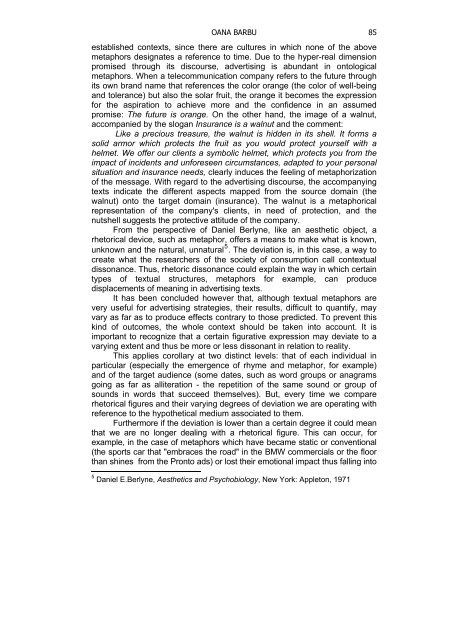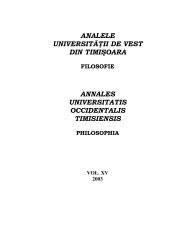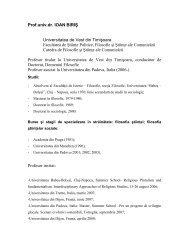VOL. IV (XXI) 2009 - Departamentul de Filosofie si Stiinte ale ...
VOL. IV (XXI) 2009 - Departamentul de Filosofie si Stiinte ale ...
VOL. IV (XXI) 2009 - Departamentul de Filosofie si Stiinte ale ...
Create successful ePaper yourself
Turn your PDF publications into a flip-book with our unique Google optimized e-Paper software.
OANA BARBU 85<br />
established contexts, <strong>si</strong>nce there are cultures in which none of the above<br />
metaphors <strong>de</strong><strong>si</strong>gnates a reference to time. Due to the hyper-real dimen<strong>si</strong>on<br />
promised through its discourse, adverti<strong>si</strong>ng is abundant in ontological<br />
metaphors. When a telecommunication company refers to the future through<br />
its own brand name that references the color orange (the color of well-being<br />
and tolerance) but also the solar fruit, the orange it becomes the expres<strong>si</strong>on<br />
for the aspiration to achieve more and the confi<strong>de</strong>nce in an assumed<br />
promise: The future is orange. On the other hand, the image of a walnut,<br />
accompanied by the slogan Insurance is a walnut and the comment:<br />
Like a precious treasure, the walnut is hid<strong>de</strong>n in its shell. It forms a<br />
solid armor which protects the fruit as you would protect yourself with a<br />
helmet. We offer our clients a symbolic helmet, which protects you from the<br />
impact of inci<strong>de</strong>nts and unforeseen circumstances, adapted to your personal<br />
<strong>si</strong>tuation and insurance needs, clearly induces the feeling of metaphorization<br />
of the message. With regard to the adverti<strong>si</strong>ng discourse, the accompanying<br />
texts indicate the different aspects mapped from the source domain (the<br />
walnut) onto the target domain (insurance). The walnut is a metaphorical<br />
representation of the company's clients, in need of protection, and the<br />
nutshell suggests the protective attitu<strong>de</strong> of the company.<br />
From the perspective of Daniel Berlyne, like an aesthetic object, a<br />
rhetorical <strong>de</strong>vice, such as metaphor, offers a means to make what is known,<br />
unknown and the natural, unnatural 5 . The <strong>de</strong>viation is, in this case, a way to<br />
create what the researchers of the society of consumption call contextual<br />
dissonance. Thus, rhetoric dissonance could explain the way in which certain<br />
types of textual structures, metaphors for example, can produce<br />
displacements of meaning in adverti<strong>si</strong>ng texts.<br />
It has been conclu<strong>de</strong>d however that, although textual metaphors are<br />
very useful for adverti<strong>si</strong>ng strategies, their results, difficult to quantify, may<br />
vary as far as to produce effects contrary to those predicted. To prevent this<br />
kind of outcomes, the whole context should be taken into account. It is<br />
important to recognize that a certain figurative expres<strong>si</strong>on may <strong>de</strong>viate to a<br />
varying extent and thus be more or less dissonant in relation to reality.<br />
This applies corollary at two distinct levels: that of each individual in<br />
particular (especially the emergence of rhyme and metaphor, for example)<br />
and of the target audience (some dates, such as word groups or anagrams<br />
going as far as alliteration - the repetition of the same sound or group of<br />
sounds in words that succeed themselves). But, every time we compare<br />
rhetorical figures and their varying <strong>de</strong>grees of <strong>de</strong>viation we are operating with<br />
reference to the hypothetical medium associated to them.<br />
Furthermore if the <strong>de</strong>viation is lower than a certain <strong>de</strong>gree it could mean<br />
that we are no longer <strong>de</strong>aling with a rhetorical figure. This can occur, for<br />
example, in the case of metaphors which have became static or conventional<br />
(the sports car that "embraces the road" in the BMW commercials or the floor<br />
than shines from the Pronto ads) or lost their emotional impact thus falling into<br />
5 Daniel E.Berlyne, Aesthetics and Psychobiology, New York: Appleton, 1971




